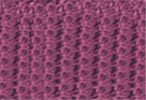
Crotchet is needlework i.e the simple drawing of one loop through another, done with a hook. You can make a variety of beautiful things like table mats, shawls, sweaters, dresses etc.with Crochet.
Materials
Hooks made of steel, plastic, aluminium and wood are available in different lengths and sizes. Steel hooks are usually used for cotton thread or fine wool work, plastic and aluminium hooks for wool, synthetics etc and wooden hooks for heavy wool (rug making). Yarns and threads are available in a variety of materials like wool (light, medium and heavy), cotton , synthetic, jute and so on.
Gauge
Gauge means the number of stitches and rows per inch. Gauge will be specified in the directions given in a particular design. When you do crocheting , it is important to maintain the gauge specified in the design to get the correct size of the article you are making.
To check the Gauge, make a sample 3 or 4 inches square patch of the stitch given. Stitch using the specified hook and yarn. Then place the patch flat on the table and with a ruler measure the number of stitches and rows per inch. For eg. Gauge= 4 stitches per inch.
If your stitch number doesn't correspond to the Gauge given for the design, try out different size hooks i.e a larger hook if you have more stitches per inch or a smaller hook for less stitches per inch until the Gauge specified is obtained.
u get many more from
here...

 all other loose ends into a solid part of crochet to fasten it securely. If yarn end is not long enough to thread into needle, use crochet hook to work the end in and out of the crochet.
all other loose ends into a solid part of crochet to fasten it securely. If yarn end is not long enough to thread into needle, use crochet hook to work the end in and out of the crochet.











































